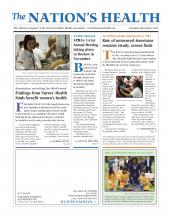The rate of uninsured Americans held steady in 2012, according to new U.S. Census Bureau data, but public health advocates expect numbers to drop dramatically as more people gain insurance under the Affordable Care Act in the coming year.
Released Sept. 17, the Census Bureau’s “Income, Poverty, and Health Insurance Coverage in the United States: 2012” report found that 48 million people were uninsured in 2012, which is not considered to be statistically different than the 48.6 million people who were uninsured in 2011. The uninsured rate declined for Asians and Hispanics from 2011 to 2012, but remained relatively unchanged for blacks and whites.
Among other findings in the annual report, which collects data based on age, gender. race, ethnicity and other factors, the number of insured Americans increased to 263.2 million in 2012, with the percentage of insured increasing from 84.3 percent to 84.6 percent. Meanwhile, 46.5 million Americans were living in poverty in 2012.

Alice Rainwater, above left, has her blood pressure checked by nursing student Alisa Humphrey during a free health care clinic in Los Angeles in 2012. The percentage of Americans without insurance held steady in 2012, the Census Bureau reports.
Photo courtesy Kevork Djansezian, Getty Images
The uninsurance findings were received positively by public health advocates, who credited the Affordable Care Act for the steadfast rates. While the 2010 law has not taken full effect, the portions of the law that are in place are having an impact.
For example, a provision of the Affordable Care Act that allows children to stay on their parents’ insurance plans until age 26 has helped reduce the numbers of uninsured young adults, said Sara Collins, PhD, vice president for health care coverage and access at the Commonwealth Fund. An increase in the number of people who are receiving insurance via government health insurance plans, such as Medicaid, has also contributed, she said.
The new Census Bureau data show the number of people covered by government health insurance programs increased from 99.5 million in 2011 to 101.5 million in 2012. The number of people covered by Medicare increased from 46.9 million in 2011 to 48.9 million in 2012.
The Congressional Budget Office predicts that about 7 million people will gain health insurance through health insurance marketplaces next year and 9 million people will get coverage through state Medicaid expansion, Collins said. Enrollment in plans offered through the marketplaces, which were created under the Affordable Care Act, began Oct. 1 and coverage will become effective as early as January.
“It really does show and underscore the fact that we need these new reforms under the Affordable Care Act that are going into effect starting in January,” Collins told The Nation’s Health. “We should continue to see a steady decline in the numbers of uninsured, and across the population and among young adults.”
One of the biggest changes documented by the Census Bureau was the decline in the rate of uninsured U.S. children. The number of uninsured children dropped from 7 million to 6.6 million in 2012. However, the uninsured rate for children living in poverty was still higher than the uninsured rate for children who are not living in poverty, at 12.9 percent and 7.7 percent, respectively, according to Census data.
Seventy percent of uninsured U.S. children are already eligible for Medicaid or the Children’s Health Insurance Program, said Alison Buist, PhD, director of child health for the Children’s Defense Fund. Some of the higher uninsurance numbers among children in poverty may be a result of confusion about enrollment requirements, Buist said.
“There are different rules in each state,” Buist told The Nation’s Health. “Some states make it really easy to get re-enrolled and to stay on Medicaid and CHIP and some states make it a lot harder. So what you see is in a lot of states…children have fallen off Medicaid or CHIP. In most cases, they’re still eligible.”
Expansions of state Medicaid programs — another part of the Affordable Care Act — are expected to play a role in reducing uninsurance rates as well. However, not all states have committed to expansion. As of September, 25 states and the District of Columbia were moving toward Medicaid expansion, 22 states were not moving forward and three were undecided, according to the Henry J. Kaiser Family Foundation.
Under an expansion, most Americans younger than age 65 who have incomes up to 133 percent of the federal poverty level would be eligible for Medicaid, a program that many low-income parents and adults without children currently do not qualify for.
APHA member Rahul Gupta, MD, MPH, FACP, health officer and executive director of the Kanawha-Charleston Health Department in Charleston, W.Va., said as the baby boom population continues to age and Medicaid programs expand, he expects to see more participation in government insurance programs.
Health workers across the country have been working to spread the word to the public about new options that are available to them. For example, Gupta said that in mid-September, the West Virginia Department of Health and Human Services sent letters to 118,000 West Virginians letting them know that they are eligible for coverage under the Medicaid expansion.
Unfortunately, some states that will not expand Medicaid are not as accepting of navigators, who are trained to disseminate information about the new health insurance marketplaces, Buist said. In Florida, which is not expanding Medicaid, the state department of health reportedly released a memo in August barring navigators from providing enrollment assistance at local health departments.
“The states aren’t making it easy for families to sign up by giving them information and the right number of navigators, and allowing navigators to work in the places where uninsured people are,” Buist said.
Other encouraging news in the new census data were findings that the rate of people covered by private insurance plans, such as through their employers, held steady for the second year in a row, at 63.9 percent.
Collins said employer-based health insurance is still a strong source of coverage and is not expected to change significantly in the next year.
“The changes in employer-based coverage over the last decade have really occurred among small employers,” Collins said. “It’s very expensive for small employers to offer health insurance to the workers right now. They will also benefit from the new insurance market reforms that will help small employers better afford coverage for their employees.”
For more information, visit www.census.gov.
Related podcast: Get more insights on the new Census Bureau insurance findings in our new podcast with Sara Collins of the Commonwealth Fund. Visit www.thenationshealth.org to listen and download the episode.
- Copyright The Nation’s Health, American Public Health Association









